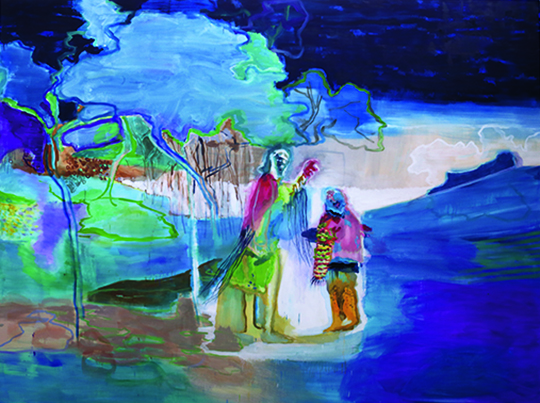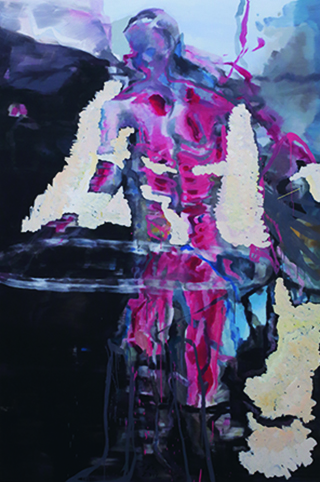ASSASSIN, HERO: FANG WEI
| March 11, 2015 | Post In LEAP 31

In Return from Sichuan, there is a relationship to religion. I create a scene that is open to misreading. Contemporary painting has extended its boundaries of interpretation. Like many things associated with painting, such as form, concept, materiality, and music, religion is a spiritual factor among many emotions. Those who paint do not have to explain the meaning of painting. It is about communion with an audience, a divine experience.
LEAP Is your practice mainly concerned with painting about painting? Art history, the body, spirituality? Where are you coming from?
FANG My understanding of painting about painting is that it is a practice regarding the nature of painting. It covers a lot, and can be addressed from different angles—from technique to concept, from history to individual spirituality. Countless artists have painted self-portraits, and so have I, although they are not exhibited in my most recent exhibition. I’m looking for an effect of spatial division. Whether or not this is related to art history, I want to express this kind of division and the alternation of multiple spaces within and beyond the painting. This is my current state of mind. Why do I paint this way? Now that I think about it, I believe it is related to my anxiety around perception, including self-perception. This is tied to history. In painting, we are able to doubt the sublime of time and space, a role of art from classical times to the contemporary moment.

LEAP What are the figures that often appear in your work? What do they represent? Are they a representation of yourself, fictional characters, or portraits of others?
FANG The fi gures i n t he works e xhibited i n t he “Assassin” e xhibition at BANK depict subjects that I’m familiar with in everyday life-friends and colleagues, or scenes that excite me. I don’t choose the subject matter in particular. I also don’t produce serial work, repeating a scene to create atmosphere. There are no fixed figures or references. When spontaneous ideas come to mind, they are often about imagined subjects. This is because of my inconsistent thinking and capricious personality. I believe it is how you paint rather than what you paint that actually matters. When you are self-absorbed, every painting is like a self-portrait, no matter what the subject matter is. The process of exploring and practicing painting is full of conjectures and assumptions—the theme arrives only later, just as the work is titled after completion.
LEAP What is the significance of the net or grid that often appears on your canvases, and how does it function in your painting?
FANG Traces of these grids or intersecting lines are left behind from my sketches. They feel like the lines of calligraphy or Chinese painting, so I’ve tried to paint a few pieces like this. The grid is a strategy. It blurs, obscures, and undermines the specific images in the paintings. Figures and portraits recede into the canvas, as if two different spaces have been collapsed onto one surface, requiring that their spatial relationships be reconstructed. Through these random grids, I want to create new feeling of space for painting.

The Gesture of Sitting depicts a colorful and realm of nirvana. I want the viewer to experience helplessness and despair in ecstasy. Then we develop a need for something like religion or mysticism. It’s as if we have the obligation to bind cultural fractures to avoid apocalyptic extinction. Many things are hard to explain in words. Before the painting is made, a certain aura is already there.
LEAP You mention the concept of a “cultural hero” in your writing. Do you feel you are a heroic painter? Or is this simply a narrative device?
FANG When I say “cultural heroism,” I mean there is an end to cultural history. Like a living being, it will have to face death even though its progress resists this conclusion. Culture, in essence, is heroic. For artists of all ages, heroism is a basic factor in production. Art is not merely a tool for craftsmen to make a living. But heroism is not the narrative theme of my work. Other feelings, such as absurdity and humor, are also involved. Though the title of the exhibition is “Assassin,” I don’t consider myself a heroic painter. But your question reminds me of my motivation to participate in cultural production to begin with. It might not be up to me, but at least I can give it a try.
LEAP Concept seems to be markedly absent from your paintings. Before your return to painting, you were noted for your conceptual engagement. Where do you hide these concepts now?
FANG I want to break through the limits of oil and seek a dialectic between multiple spaces in painting. This sounds like a technical question, but it is in fact a channel leading the visual to the spiritual. For me, concept lies in the consideration of painting’s modernity, so perhaps it is indeed buried in technical questions. I used to think about a lot of so-called “concepts” when I was working with other artists—incense ash, woodcut, sculptures—but now I feel these ideas were mostly just tricks. I hope to create a deeper space in my work, even while flattening the painting with even brushwork and a sealed surface. The tension between depth and surface produces a visual paradox that leads you into a painting: you are attracted by the materiality of the surface but are kept outside.

LEAP Outside your studio in Shanghai, do you also make sketches or other experiments on your travels? How do you incorporate external experiences into your work?
FANG I have been painting since 2009. Before that I traveled for a while, and became sure that I really had been thinking about painting. Standing on the mountains in Sichuan and Nepal, having conversations with Lamas on the temple square in Bhutan—these experiences with nature outside the studio gradually enter into and awaken emotions around my work. Traveling on foot is meaningful. I have experienced difficulty and fear, fantasy and the indispensability of love. I don’t paint on the road, but I take photographs as documentation.


